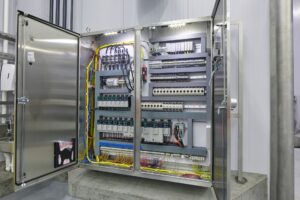Traffic and street light installations are not a pretty sight. The sidewalk is torn up, dirt piled high, traffic backed up (or rerouted altogether), and the whole process is a huge disruption.
Not to mention, those open ditches from digging and trenching that been the site of too many workers injuries.
That’s why electrical contractors prefer directional drilling (or, directional boring), as a means to install telecommunications, conduits and underground utility lines without causing damage to the surface.
Here’s how it works
Think of it like non-invasive surgery. The drillbit is guided by real-time technologies from the entry to the target, and able to work on an area from a far distance. Once it’s done the necessary work, the bit is pulled back up through the entry point.
Behind that process is plenty of planning, navigating, and thorough training for software and steering tools.
It’s actually been around for awhile
This technique was used by the oil and gas industry in the 1920s, as it helped them access reserves that were difficult to reach. The process works the same now, except we have advanced technologies—such as 3D measuring systems, drill sensors, and bottom hole assembly configurations (BHA)—that bring on a whole new level of efficiency.
Projects are now much larger in scope. A company fully capable in directional drilling could run a line that’s over a mile long!
Here are some of the advantages
- This is an extremely useful method for city environments. For one, you don’t have to shut down the whole intersection just because you’re working on the traffic light, or installing underground cables. There’s also far less clean-up, or need for roads getting cut or needing to be repaved.
- Costs are lowered in the long run, since fewer workmen are required on-site. You also have the technology to safely avoid utilities buried in the area, which could be a source of future costs. It’s also a much quicker process than open trenching, as well as backfilling in an area without underground conflicts.
- Directional drilling has been praised for it’s lessening impact on the environment. Traditional drilling used to destroy landscapes. Now, you can run a cable under a lake and hardly notice a team had been there in the first place. You can see the effect in cities as well. For example, mud run off is minimized because the drilling is not affecting the top layer of the soil.
Now, not every electrician has the necessary equipment—nor the labor skills—to complete this type of installation. We have completed several projects in directional drilling, and have the technology and expertise to handle any work of this type.
Give us a call if you have a project that involves directional drilling. We are happy to discuss your needs and what it takes to solve them.


